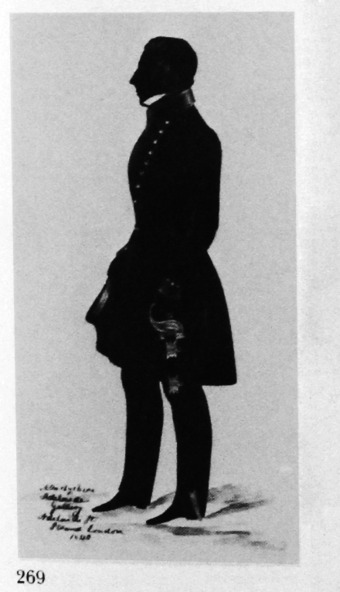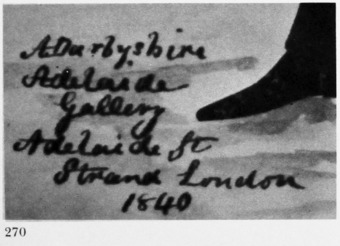Adelaide Gallery (British Silhouette..., Section 1, 1978)
This gallery, recorded by Mills, was situated in the street after which it was named, Adelaide Street, London. This street ran northwards from the Strand almost opposite where Charing Cross Station stands.
The silhouette was probably not the most important of the gallery's fields of activity. We know, for instance, that the second Daguerreotype Studio was opened by Antoine Claudet on the roof of the 'Royal Adelaide Gallery' in June 1841. The silhouette gallery. (if, as we can surely assume, it was the same one) was however in existence before 1841, as the only examined signed silhouette from the gallery is dated 1840. It is signed by an artist named A. Darbyshire, an example of whose work was formerly in the Wellesley collection, though whether or not Darbyshire executed this while he was working for the Adelaide Gallery we do not know. Another artist who worked at the gallery, named Barber, is listed by Mills. Three artists of the name of Barber were included by Jackson in her Dictionary. One was a boy aged only ten at the time of the Great Exhibition in 1851 (see Barber, Master). The two others, with initials C. L. and M. S. respectively (qq.v.), are recorded by Jackson as having worked during the 1820s and either of them may eventually have joined the Adelaide Gallery. The surname is, however, too common for there to be any certainty on this point, and no artist of the surname of Barber listed by Foskett appears to have worked at the relevant period. It is at any rate evident that more than one artist worked at the gallery, and that, of these, two may also have worked independently.
183
It is not possible, owing to the paucity of signed or labelled work, to say how long the studio at the Adelaide Gallery flourished.
The extant silhouette by Darbyshire represents a naval subject. It is cut from black paper (the edges of which have been well concealed), and it was afterwards bronzed. This bronzing is above the average level of skill for the period, the execution of the decoration on the sword being particularly careful. All the bronzing appears to have been executed with a fine brush, and gum arabic was used with discrimination, being confined to the sword itself and to the belt from which it is slung. Other detail is shown in gold. The whole figure is 7 in. high, and stands on an indifferently painted wash base. The bold inscription near the right foot is in pen and ink. The remnant of a label on the back of the gilt frame bears the words 'GALLERY OF THE FINE ARTS', and also shows part of a coat-of-arms. This fragment may of course be part of the frame-maker's label, but it is just possible that the gallery was under Royal Appointment.
Apart from this fragment, there seems to be no record of any trade label used by the gallery, although a label probably was used.
Ills. 269, 270

? Unknown naval subject
Cut silhouette
1840
9¾ x 8in./248 x 204mm.
Frame: wooden, leafed
Signed by the artist, A. Darbyshire.
Author’s collection

Inscription from the illustrated silhouette (269) produced by The Adelaide Gallery.
Author’s collection
